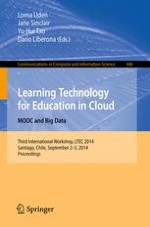2014 | Buch
Learning Technology for Education in Cloud. MOOC and Big Data
Third International Workshop, LTEC 2014, Santiago, Chile, September 2-5, 2014. Proceedings
herausgegeben von: Lorna Uden, Jane Sinclair, Yu-Hui Tao, Dario Liberona
Verlag: Springer International Publishing
Buchreihe : Communications in Computer and Information Science
